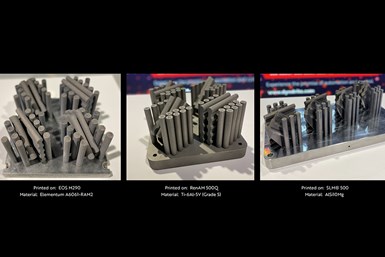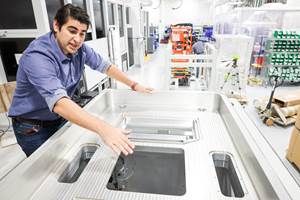Dyndrite, UPM Work to Bring Data Intelligence to Metal 3D Printing Build Plates
The collaboration aims to reduce print failures and enable reliable supply chain for additive manufacturing production.
Dyndrite showcases parametrically created ASTM qualification build plates for major LPBF platforms. It provides materials and process development scientists and engineers with toolpath control. Photo Credit: Dyndrite
Dyndrite and United Performance Metals (UPM) Additive Solutions are collaborating to bring intelligence to critical, yet often ignored 3D printing components. The companies will work together to capture and provide the data that unlocks the variables to build plate life, and bring supply chain predictability and reliability to new and resurfaced build plates.
Dyndrite is a provider of the core Accelerated Computation Engine (ACE) and Application Development Kit (ADK) which is used to create digital manufacturing hardware and software. UPM Additive Solutions is a supplier of metal build plates for the additive industry. The companies are bringing together their expertise to create “smart” metal build plates for the 3D metal printing industry.
The partners say the build plate is an integral component in metal 3D printing because it lays the foundation for every part being built. Unfortunately, most users in the space do not record key data that can unlock the unknowns concerning the life cycle and history of their build plates. Without this information, for example, laser powder bed fusion (LPBF) users face an increased risk of powder leveling issues, internal fatigue and plate warpage that can lead to lost time and costly build failures.
“UPM is excited to partner with Dyndrite and its metal users to unlock the keys to build plate life,” says Chris Prue, applications development manager at UPM Additive Solutions. “Through data, we can put knowledge in the hands of the user to raise throughput and reduce failures. Build plate usage data helps customers understand and manage their usage, and demand for plates to keep costs low while keeping inventory available to reduce downtime. Through smart build plates and a reliable supply chain, we can collectively mature and grow the industry.”
The partners say the AM industry must develop new tools to enable the industry to scale. “ By working with UPM and leveraging the power of machine data we can accelerate learning, improve predictability and grow,” says Harshil Goel, Dyndrite founder and CEO. “Through insights of the data, we allow users to make less risky decisions on their build plates to assure success.”
UPM currently offers subscription-based services to track build plates from initial manufacture to customer and through its refurbishment. Each plate is serialized and maintains accessible quality inspection data. Smart Build Plate customers can view build data associated with each plate from the machine (preheat, laser power, powder melted, heat treatment, stress relief) along with other conditions to which the build plate will be exposed. The UPM Smart Build Plate service will support all major metal 3D printer OEMs, including Aconity, EOS, Renishaw and SLM Solutions, and is expected to roll out in Q3 2023.
- Learn more about United Performance Metals’ work as a one-stop build plate shop for production AM. The company offers full refurbishment and inventory management for this critical additive supply.
- Read about President Biden’s announcement for the AM Forward additive manufacturing initiative which he discussed during a visit at United Performance Metals in Cincinnati, Ohio.
- Take a look at this post about Dyndrite’s collaboration with AMFG for cross-platform 3D metal automated production. AMFG powered by Dyndrite is an integrated solution that is said to unlock the full potential of metal 3D printing by bringing order-to-part automation, eliminating bottlenecks and streamlining the entire production process for increased efficiency and cost savings.
Related Content
Big Metal Additive: The Difference Between a Shape and a Part Is Quality
Preparing to scale directed energy deposition to ongoing full production is not a technological challenge: DED is ready. But it is an organizational challenge, says the company founder. Here is what it means to implement a quality system.
Read MoreSeurat: Speed Is How AM Competes Against Machining, Casting, Forging
“We don’t ask for DFAM first,” says CEO. A new Boston-area additive manufacturing factory will deliver high-volume metal part production at unit costs beating conventional processes.
Read MoreThis Year I Have Seen a Lot of AM for the Military — What Is Going On?
Audience members have similar questions. What is the Department of Defense’s interest in making hardware via 3D printing over conventional methods? Here are three manufacturing concerns that are particular to the military.
Read MoreHow Machining Makes AM Successful for Innovative 3D Manufacturing
Connections between metal 3D printing and CNC machining serve the Indiana manufacturer in many ways. One connection is customer conversations that resemble a machining job shop. Here is a look at a small company that has advanced quickly to become a thriving additive manufacturing part producer.
Read MoreRead Next
Postprocessing Steps and Costs for Metal 3D Printing
When your metal part is done 3D printing, you just pull it out of the machine and start using it, right? Not exactly.
Read MoreBike Manufacturer Uses Additive Manufacturing to Create Lighter, More Complex, Customized Parts
Titanium bike frame manufacturer Hanglun Technology mixes precision casting with 3D printing to create bikes that offer increased speed and reduced turbulence during long-distance rides, offering a smoother, faster and more efficient cycling experience.
Read MoreAlquist 3D Looks Toward a Carbon-Sequestering Future with 3D Printed Infrastructure
The Colorado startup aims to reduce the carbon footprint of new buildings, homes and city infrastructure with robotic 3D printing and a specialized geopolymer material.
Read More





















